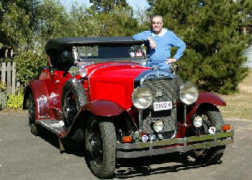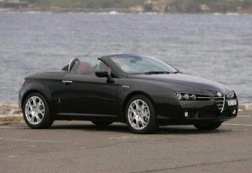But those big accidents, they'll always happen to someone else, not me. And as much as I hate to admit it, I think I had fallen into this mindset. That was before I attended an advanced driver training course this week.
When learning how to drive, we are simply taught to get our licence, as my instructor at the BMW Young Driver Training course, Derek Walls, told us.
"With every other form of vehicle — motorbikes, heavy vehicles, light vans — you have to go further," he says.
"But basically, when it comes to a car licence, that's it. You get your licence and don't have to do anything else."
And it's true. In most cases, you're not taught how to avoid an accident, how dangerous travelling too close to the car in front can really be or the importance of wide vision.
I arrived at the course to find I was on the older side of young drivers. My six fellow motorists were on their P-plates.
And while they were all keen on driving a brand new 3 Series BMW for the day and hitting the racetrack, it seemed they were all there because of the initiative of parents or relatives. Some had first-hand accident stories, others told of friends who were lucky to have escaped some sticky situations.
But it became clear from the start that we all shared that optimism in our abilities. So it was off to the classroom for a reality check.
After some theory, we were off to put it into practice. Braking, the correct steering technique and swerving to avoid an accident were first on the list. There were some tangled arms as we tried to adjust to new hand positioning, burnt rubber as we learned the benefit of ABS and how to control a car without this technology, and quite a few witches hats taken out along the way.
And while it was heaps of fun and most of the exercises were done with smiles on our faces, as well as a few butterflies in our stomachs, we all absorbed a wealth of knowledge we had previously taken for granted.
After lunch it was off for some more theory and practical exercises and then came time for what most of the boys had been waiting for, hitting the track. Our 110km/h felt considerably fast, but to finish the day off, we saw real speed in action. Our instructors took us for some hot laps in their BMW M3s.
Some people may criticise these courses for encouraging unsafe driving behaviour. But as Walls says, advanced driver training courses show young people their limits and encourage them to work within them.
His motto is simple: "Speed that thrills is speed that kills." If you're getting excited by your driving, you're outside your comfort zone.
The treat of some hot laps at the end of the day demonstrated just how much technique and experience is required to carry off such speeds with precision. We were all pretty much agreed that we were yet to possess the experience required to execute such a task.
"Let them experience and they will go away and make their own decision, but you have to give them the correct tools to make accurate decisions," Walls says.
While most courses require you to bring your own car, this one had us all drive the same BMWs. Walls warns that some courses may not be as qualified as you think, so people should do some research before booking one.
Back on the road, I've noticed I'm putting all my new skills into practice. I'm now much more alert, I'm giving extra room between my car and the car in front and I'm practising and mastering my turning technique.
Experiencing actions such as braking or swerving suddenly at 80km/h shows just how hard these tasks are, something you can't quite comprehend until you experience it.
I know I'd rather this on the track than in real driving conditions. With the disastrous effects of over-confident young drivers continually in the news, a driver training course could just be the wake-up call they need.
How to drive safely
Vision
If there's one thing we're not good at, it is looking far enough ahead. In most cases we just don't do this and fail to focus far enough ahead. Keep your head up and always be aware of what is going on around you. Look out to see what's coming next. Good observation really is the key.
Braking
Early is better. The bottom line is if you think you need to brake, then you do. Leave two to three seconds between yourself and the car ahead. A car travelling 100km/h takes 80m to stop with reaction time. Incredibly, that's nearly as long as a football field.
Seating position
You should be in a comfortable position, but your legs must not be straight or too cramped. You should be able to fit only four fingers above your head before reaching the roof. You should be comfortable and in control in all situations. Your leg can't become locked under braking.
Peer pressure
There's always peer pressure, which is especially true for young blokes. Don't cave in to these demands. "Speed that thrills is speed that kills." If you're getting excited, then you're driving outside your comfort zone.








.jpg)
.jpg)
.jpg)

.jpg)
.jpg)
.jpg)

.jpg)









.jpg)

Comments